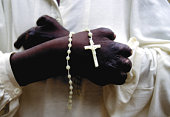
12 January 2006: Thursday of the 1st Week in Ordinary Time
Mark 1, 40-45: The Healing of the Leper
Leprosy today, thanks to MDT, is not anymore regarded as an incurable disease. But in biblical times, leprosy was regarded with abomination. Leprosy is not just the typical nodular, tubercular or anaesthetic leprosy we know today as Hansen’s disease. The Hebrew term covers a wide range of skin diseases such as an-an, buni, alipunga or had-had. Anyone covered with psoriasis, thus, was considered a leper. The discoloration of the skin turning it white, is what was referred to as “a leper as white as snow.” In the Book of Numbers (12, 9ff), the Lord made Miriam, a ‘snow-white leper’ as a punishment for her jealousy over Moses’ superior position. She said, “Is it through Moses alone that the Lord speaks? Does he not speak through us also?
Any such skin disease renders the sufferer unclean. He was banished from the fellowship of men; he must dwell alone outside the camp; and he must ward everyone of his presence with the cry, ‘Unclean, unclean.’ It is being marked with the ‘scarlet letter.’ The leper had not only to bear the physical pain of his disease; he had to bear the mental anguish and the heartbreak of being completely ostracized from human society.
There is obviously no Hansenite in many places. But we are all lepers. Sadly and unconsciously (or sometimes consciously), we accord the plight of lepers to others and, unknowingly, to ourselves for the same reasons we justify our malaise. By ostracizing others, we actually give reason for other people to shun us. We fail to see that by inflicting wounds on others, we actually infect the disease on ourselves.
In this world of psychology, everything is blamed on the complexity of our personalities and traumatic childhood experiences. But never on ourselves. If that is the case, there is practically no solution at all.
But we all know that the medications to any paranoia are the same medicines Jesus gave to the leper almost two thousand years ago: kind words and a compassionate touch. First, Jesus never drove away the leper for breaking the law. The leper has no right to talk to him and yet, Jesus met the leper’s desperate need with kindness. Second, Jesus stretched out his hand and touched him. He was not afraid to be unclean and shunned. Compassion is beyond the need to maintain a good image. Finally, Jesus sent him to fulfill the purification rituals needed for him to be accepted in the community. The shepherd brought back the lost sheep to the fold.
Perhaps today as we slip into the de more, the Ordinary Time as the liturgical calendar indicates, we begin to see beyond our own psychological leprosy, and go to those we had inflicted the disease on. People who render with kind words and touch other peoples’ hearts live genuinely happy. Totally well. And perfectly healed.
No comments:
Post a Comment